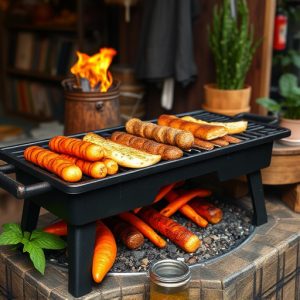Selecting the perfect cut of ribs (baby back or spare) for your BBQ rib recipe is key, offering different textures and flavors. Marinate and season with paprika, garlic powder, salt, pepper, and brown sugar for rich tastes. Preheat your grill to 450°F (230°C), sear the ribs, then reduce heat to 300°F (150°C) until an internal temp of 175°F (80°C) is reached, ensuring tender, juicy grilled BBQ rib recipes.
Unleash the ultimate BBQ experience with our guide to crafting mouthwatering grilled ribs with a tangy glaze. Discover the secrets behind choosing the perfect cut, from baby back to spare rib, each with its distinct flavor profile. Learn about marinating and seasoning techniques that transform your ribs into a culinary masterpiece. Master grilling methods, ensuring optimal taste through precise temperature control. Finally, create a tantalizing glaze that balances sweetness and acidity perfectly. Elevate your BBQ game with this comprehensive guide for the best grill rib recipe around!
- Choosing the Perfect Ribs for Your BBQ Rib Recipe
- – Tips on selecting the right cut of ribs (baby back, spare rib, etc.) and their unique characteristics.
- Marinating and Seasoning: Laying the Foundation for Flavorful Grilled Ribs
- – Importance of marination and various seasoning blends to enhance taste. Discuss different rubs and their ingredients.
- The Art of Grilling: Techniques for Perfectly Cooked Ribs
Choosing the Perfect Ribs for Your BBQ Rib Recipe
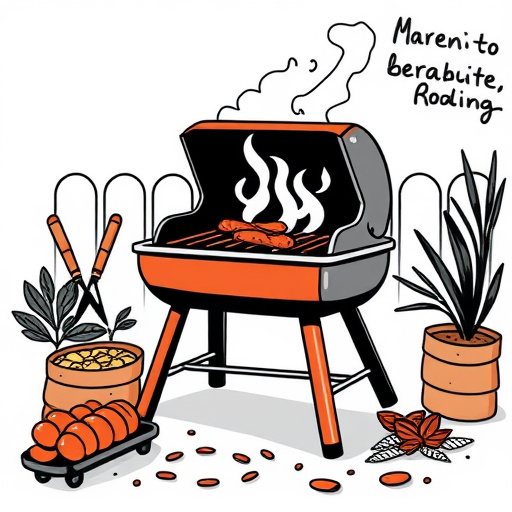
When it comes to crafting the perfect BBQ rib recipe, selecting the right ribs is half the battle won. Look for meaty, well-marbled ribs with a good layer of fat—this ensures they’ll stay juicy and tender during the grilling process. The most common cuts are baby back and spareribs, each offering distinct flavors and textures. Baby back ribs are leaner, resulting in a sweeter glaze and a more delicate taste, while spareribs are larger, providing a hearty, robust flavor due to their higher fat content.
For ultimate grill success, opt for high-quality, grass-fed ribs if possible. Their superior marbling ensures consistent moisture and flavor. Additionally, consider the age of your ribs; younger pigs typically produce ribs with a lighter, more delicate taste, while older ones offer a richer, deeper flavor profile. No matter your choice, ensure they’re well-chilled before grilling to help them cook evenly.
– Tips on selecting the right cut of ribs (baby back, spare rib, etc.) and their unique characteristics.
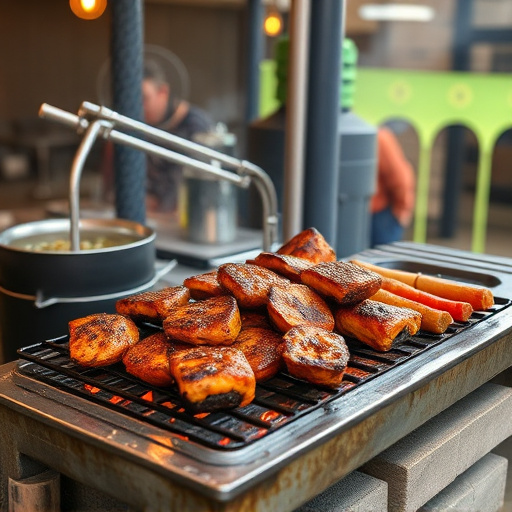
When it comes to grilling ribs, choosing the right cut is key to achieving that perfect blend of tender meat and robust flavor. Baby back ribs are a popular choice for BBQ rib recipes due to their smaller size and milder taste. They’re ideal for those who prefer a more delicate, sugary glaze as they cook up nice and tender with minimal marbling. On the other hand, spare ribs offer a heartier, chewier experience despite requiring a bit more time on the grill. Their thick cut allows for a richer, smokier flavor to develop, making them perfect for those who enjoy a robust BBQ rib recipe with a bold glaze.
Consider the desired tenderness and flavor profile when selecting your ribs. For a quicker cook time and a more tender result, opt for baby back. If you’re looking to savor every chew and want a richer taste, spare ribs are your best bet. No matter which cut you choose, ensure you select high-quality, meaty ribs with minimal fat for the best grill marks and juicy results in your BBQ rib recipe.
Marinating and Seasoning: Laying the Foundation for Flavorful Grilled Ribs
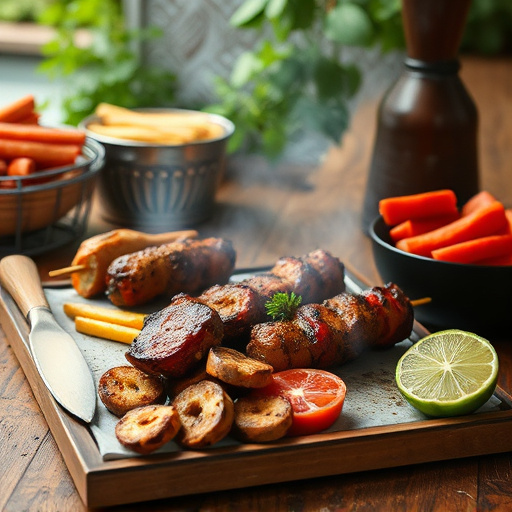
Marinating and seasoning are key steps in creating flavorful grilled ribs with a tangy glaze. To start, choose a high-quality cut of pork ribs, such as baby back or St. Louis style. Before grilling, a wet rub of spices like paprika, garlic powder, salt, pepper, and brown sugar helps to penetrate the meat and create a rich flavor profile. This step should not be skipped; it lays the foundation for your BBQ rib recipe.
For an extra boost in flavor, consider marinating the ribs in a mixture of vinegar, soy sauce, mustard, and liquid smoke for several hours or even overnight. This tangy marinade not only adds complexity to the taste but also helps tenderize the meat. Ensure the ribs are well-coated before placing them on the grill, allowing the flavors to meld together as they cook, resulting in mouthwatering grilled rib recipes that will satisfy any appetite.
– Importance of marination and various seasoning blends to enhance taste. Discuss different rubs and their ingredients.
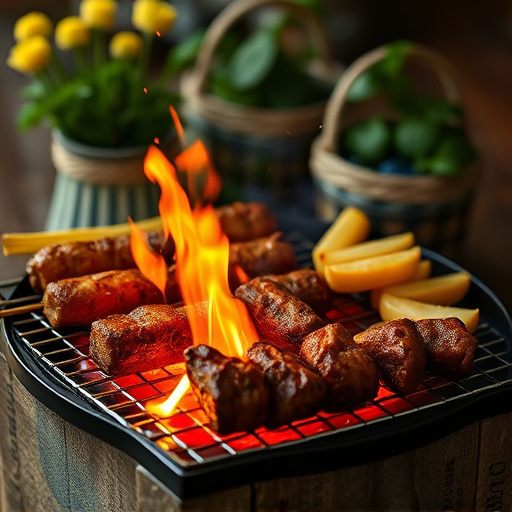
The key to unlocking the true flavor potential of grilled ribs lies in the art of marination and seasoning. Before hitting the grill, ribs need a good soak in a blend of spices and sauces to penetrate their dense structure and elevate their natural sweetness. Marination not only tenderizes the meat but also amplifies its inherent juices, resulting in a richer, more complex taste profile.
Seasoning blends for grilled ribs vary widely, offering a spectrum of flavors from smoky and savory to sweet and tangy. Classic rubs often include ingredients like brown sugar, paprika, garlic powder, salt, and pepper, creating a balanced mix that complements the barbecue smoke. More adventurous combinations might feature chili powder, coriander, cumin, or even dried herbs like rosemary and thyme, adding unique notes and depth to each bite. Experimenting with different rubs allows you to personalize your BBQ rib recipe, catering to specific taste preferences and making every grilling session memorable.
The Art of Grilling: Techniques for Perfectly Cooked Ribs
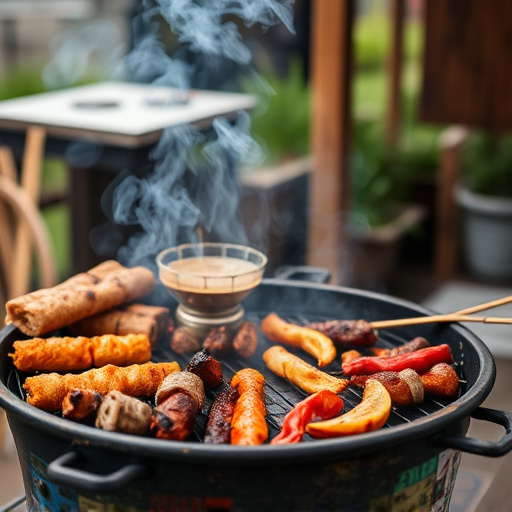
The art of grilling perfect ribs involves a combination of precise cooking techniques and patience. It’s essential to start with high heat to sear the exterior, locking in flavors, before transitioning to lower heat for slow-cooking until tender. This two-step process ensures ribs become juicy and fall-off-the-bone.
For best results, preheat your grill to sear at 450°F (230°C). Grill each side for about 5 minutes for a good char. Then, reduce the heat to around 300°F (150°C) and continue cooking until the ribs reach an internal temperature of 175°F (80°C). This method ensures a delightful contrast between caramelized exterior and tender, succulent meat—the hallmark of a perfect BBQ rib recipe.
